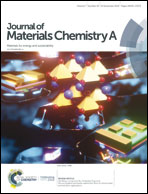Suppressing photo-oxidation of non-fullerene acceptors and their blends in organic solar cells by exploring material design and employing friendly stabilizers†
Abstract
In addition to a high power conversion efficiency, ambient stability is another impact factor for the successful commercialization of organic solar cells (OSCs). Understanding the role of photovoltaic materials is the key to address this challenge, but no such studies have been systematically performed on non-fullerene acceptors (NFAs). In this work, we firstly investigate the role of NFA photo-oxidation in device degradation. Relevant investigation of physical dynamics underlines the effects on the device performance for NFA photo-oxidation acting as trap states in exposed blends. In addition, taking ITIC as an example, we shed some light on the possible mechanisms of NFA photo-oxidation, which cannot be eliminated by relevant strategies and principles of material design. These results drive us to further investigate the photobleaching rates of thirty-three NFAs, including fused-ring electron acceptors and perylene diimide acceptor derivatives. Surprisingly, most of them show a higher optical density loss as compared to their fullerene-based counterparts. In view of relevant comparative analysis in the Discussion section, we further propose some design strategies to improve the photo-oxidation stability of NFAs. More importantly, we also find a stabilizer (namely nickel chelate S6) that can effectively suppress the photo-oxidation of NFAs and their blends and thus improve the ambient stability of OSCs.



 Please wait while we load your content...
Please wait while we load your content...